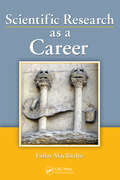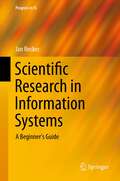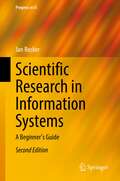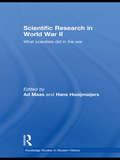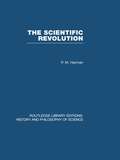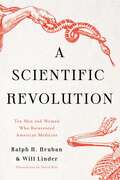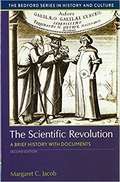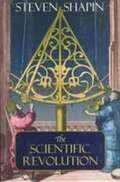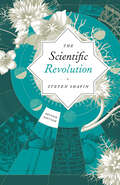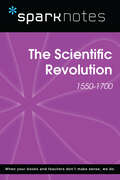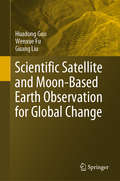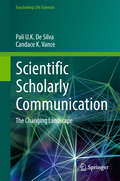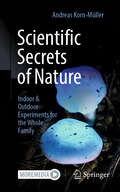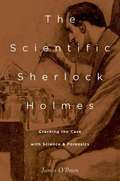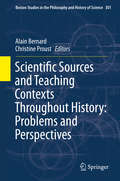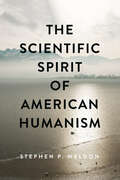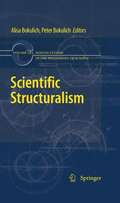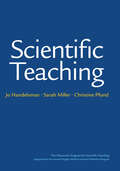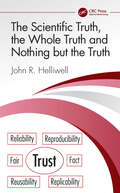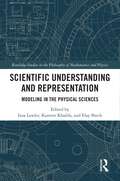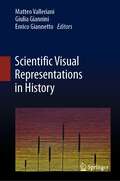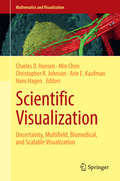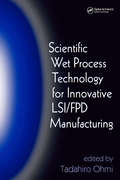- Table View
- List View
Scientific Research as a Career
by Finlay MacRitchieDescribing the philosophy of the scientific method and the training and professional characteristics needed for a successful career, Scientific Research as a Career is a comprehensive "how-to" guide for the aspiring scientist. Based on the author's experience both as a scientist in a research organization and as a university mentor, the book covers
Scientific Research in Information Systems
by Jan ReckerThis book is designed to introduce doctoral and other higher-degree research students to the process of scientific research in the fields of Information Systems as well as fields of Information Technology, Business Process Management and other related disciplines within the social sciences. It guides research students in their process of learning the life of a researcher. In doing so, it provides an understanding of the essential elements, concepts and challenges of the journey into research studies. It also provides a gateway for the student to inquire deeper about each element covered . Comprehensive and broad but also succinct and compact, the book is focusing on the key principles and challenges for a novice doctoral student.
Scientific Research in Information Systems: A Beginner's Guide (Progress in IS)
by Jan ReckerThis book introduces higher-degree research students and early career academics to scientific research as occurring in the field of information systems and adjacent fields, such as computer science, management science, organization science, and software engineering. Instead of focusing primarily on research methods as many other textbooks do, it covers the entire research process, from start to finish, placing particular emphasis on understanding the cognitive and behavioural aspects of research, such as motivation, modes of inquiry, theorising, planning for research, planning for publication, and ethical challenges in research. Comprehensive but also succinct and compact, the book guides beginning researchers in their quest to do scholarly work and to assist them in developing their own answers and strategies over the course of their work. Jan Recker explains in this book the fundamental concepts that govern scientific research and then moves on to introduce the basic steps every researcher undertakes: choosing research questions, developing theory, building a research design, employing research methods, and finally writing academic papers. He also covers essentials of ethical conduct of scientific research. This second edition contains major updates on all these elements plus significant expansions on relevant research methods such as design research and computational methods, a rewritten and extended chapter on theory development, and expansions to the chapters on research methods, scientific publishing, and research ethics. A companion website provides pedagogical materials and instructions for using this book in teaching.
Scientific Research In World War II: What scientists did in the war
by Ad Maas Hans HooijmaijersThis book seeks to explore how scientists across a number of countries managed to cope with the challenging circumstances created by World War II. No scientist remained unaffected by the outbreak of WWII. As the book shows, there were basically two opposite ways in which the war encroached on the life of a scientific researcher. In some cases, the outbreak of the war led to engagement in research in support of a war-waging country; in the other extreme, it resulted in their marginalisation. The book, starting with the most marginalised scientist and ending with those fully engaged in the war-effort, covers the whole spectrum of enormously varying scientific fates. Distinctive features of the volume include: a focus on the experiences of ‘ordinary’ scientists, rather than on figureheads like Oppenheimer or Otto Hahn contributions from a range of renowned academics including Mark Walker, an authority in the field of science in World War II a detailed study of the Netherlands during the German Occupation This richly illustrated volume will be of major interest to researchers of the history of science, World War II, and Modern History.
The Scientific Revolution (Routledge Library Editions: History & Philosophy of Science)
by Peter HarmanOriginally published in 1983.This volume outlines some of the important innovations in astronomy, natural philosophy and medicine which took place in the sixteenth and seventeenth centuries, and shows how the transformation in world-view during the period was affected by broader historical terms. Themes such as the spread of Puritanism, the decline of witchcraft and magic, and the incorporation of science as an integral part of the intellectual milieu of late seventeenth-century England.
A Scientific Revolution: Ten Men and Women Who Reinvented American Medicine
by Dr. Ralph H. Hruban William LinderA prismatic examination of the evolution of medicine, from a trade to a science, through the exemplary lives of ten men and women. Johns Hopkins University, one of the preeminent medical schools in the nation today, has played a unique role in the history of medicine. When it first opened its doors in 1893, medicine was a rough-and-ready trade. It would soon evolve into a rigorous science. It was nothing short of a revolution. This transition might seem inevitable from our vantage point today. In recent years, medical science has mapped the human genome, deployed robotic tools to perform delicate surgeries, and developed effective vaccines against a host of deadly pathogens. But this transformation could not have happened without the game-changing vision, talent, and dedication of a small cadre of individuals who were willing to commit body and soul to the advancement of medical science, education, and treatment. A Scientific Revolution recounts the stories of John Shaw Billings, Max Brödel, Mary Elizabeth Garrett, William Halsted, Jesse Lazear, Dorothy Reed Mendenhall, William Osler, Helen Taussig, Vivien Thomas, and William Welch. This chorus of lives tells a compelling tale not just of their individual struggles, but how personal and societal issues went hand-in-hand with the advancement of medicine.
The Scientific Revolution: A Brief History with Documents (The Bedford series in History and Culture)
by Margaret JacobThe Scientific Revolution highlights the difficulty of engaging, discarding, or assimilating religious paradigms in the course of scientific development. Jacob's introduction outlines the trajectory of the Scientific Revolution and argues that the revival of ancient texts in the Renaissance and the upheaval of the Protestant Reformation paved the way for science.
The Scientific Revolution
by Steven ShapinA historical exploration of the origins of the modern scientific worldview. The author rejects the idea that there was anything like a "revolution" in early modern science, instead asserting that scientific knowledge was advanced through social practices for social purposes, and was met as much with skepticism and rejection as with celebration and praise. Annotation c. by Book News, Inc. , Portland, Or.
The Scientific Revolution (science.culture)
by Steven Shapin“There was no such thing as the Scientific Revolution, and this is a book about it.” With this provocative and apparently paradoxical claim, Steven Shapin begins his bold, vibrant exploration of the origins of the modern scientific worldview, now updated with a new bibliographic essay featuring the latest scholarship. “An excellent book.”—Anthony Gottlieb, New York Times Book Review “Timely and highly readable. . . . A book which every scientist curious about our predecessors should read.”—Trevor Pinch, New Scientist “Shapin's account is informed, nuanced, and articulated with clarity. . . . This is not to attack or devalue science but to reveal its richness as the human endeavor that it most surely is. . . . Shapin's book is an impressive achievement.”—David C. Lindberg, Science “It's hard to believe that there could be a more accessible, informed or concise account. . . . The Scientific Revolution should be a set text in all the disciplines. And in all the indisciplines, too.”—Adam Phillips, London Review of Books
The Scientific Revolution (SparkNotes History Notes)
by SparkNotesThe Scientific Revolution (1550-1700) (SparkNotes History Note) Making the reading experience fun! SparkNotes History Guides help students strengthen their grasp of history by focusing on individual eras or episodes in U.S. or world history. Breaking history up into digestible lessons, the History Guides make it easier for students to see how events, figures, movements, and trends interrelate. SparkNotes History Guides are perfect for high school and college history classes, for students studying for History AP Test or SAT Subject Tests, and simply as general reference tools.Each note contains a general overview of historical context, a concise summary of events, lists of key people and terms, in-depth summary and analysis with timelines, study questions and suggested essay topics, and a 50-question review quiz.
Scientific Satellite and Moon-Based Earth Observation for Global Change (Springer Remote Sensing/photogrammetry Ser.)
by Huadong Guo Wenxue Fu Guang LiuGlobal change involves complex and far-reaching variations in the Earth’s systems, and satellite observations have been widely used in global change studies. Over the past five decades, Earth observation has developed into a comprehensive system that can conduct dynamic monitoring of the land, the oceans and the atmosphere at the local, regional and even global scale. At the same time, although a large number of Earth observation satellites have been launched, very few of them are used in global change studies. The lack of scientific satellite programs greatly hinders research on global change. This book proposes using a series of global change scientific satellites to establish a scientific observation grid for global environmental change monitoring from space, and offers the first comprehensive review of lunar-based Earth observation. These scientific satellites could provide not only basic datasets but also scientific support in facilitating advances in international global change research.
Scientific Scholarly Communication
by Pali U. K. Silva Candace VanceThis book critically examines the historical developments and current trends in the scientific scholarly communication system, issues and challenges in scientific scholarly publishing and scientific data sharing, implications and debates associated with the influence of intellectual property rights on scientific information sharing, and new trends related to peer reviewing and measuring the impact of scientific publications. Based on thorough examination of published literature, the book illustrates the involvement of many stakeholders--scientists, science educators, university administrators, government entities, research funders, and other interested parties--in this complex and dynamic system. The discussion highlights the roles these stakeholders have to play, individually and collaboratively, to help transform the future of the scientific scholarly communication system.
Scientific Secrets of Nature: Indoor & Outdoor Experiments for the Whole Family
by Andreas Korn-MüllerIn this book, you and your children will discover the amazing wonders of nature through simple experiments. What's the science behind the Lotus effect? Find out using kohlrabi leaves. Feeding carnivorous plants with gummy bears? Yes, it works! But why? Determine the air quality of your surroundings, a park, or a forest with a homemade lichen grid. Quickly, you'll become an expert on the wonderful and useful lichens. Invisible microorganisms of a lake become visibly teeming life with a laser pointer – all without a microscope! Discover the "dark" side of nature with a simple UV flashlight, making vegetables, plants, mosses, fungi, algae, crabs, and shells glow in vibrant colors. A red glowing spooky bell pepper for Halloween? Yes! An exploratory night walk on the beach? Hooray! Great fun with experiments for indoors and outdoors for the whole family. This book is the perfect companion for hikes and holiday travels – bringing you closer to nature. Featuring numerous color photos, many descriptive graphics, and 14 spectacular videos. So: Off into nature!
The Scientific Sherlock Holmes: Cracking the Case With Science and Forensics
by James O'BrienOne of the most popular and widely known characters in all of fiction, Sherlock Holmes has an enduring appeal based largely on his uncanny ability to make the most remarkable deductions from the most mundane facts. The very first words that Sherlock Holmes ever says to Dr. Watson are, "How are you? You have been in Afghanistan, I perceive. " Watson responds, "How on earth did you know that?" And so a crime-solving legend is born. In The Scientific Sherlock Holmes, James O'Brien provides an in-depth look at Holmes's use of science in his investigations. Indeed, one reason for Holmes's appeal is his frequent use of the scientific method and the vast scientific knowledge which he drew upon to solve mysteries. For instance, in heart of the book, the author reveals that Holmes was a pioneer of forensic science, making use of fingerprinting well before Scotland Yard itself had adopted the method. One of the more appealing aspects of the book is how the author includes real-world background on topics such as handwriting analysis, describing how it was used to capture the New York Zodiac killer and to clinch the case against the Lindbergh baby kidnapper. Sherlock Holmes was knowledgeable about several sciences, most notably chemistry. Therefore the book takes a close look at Holmes the chemist and discusses, for example, chemical poisons such as carbon monoxide, chloroform, and Prussic acid (the historical name for hydrogen cyanide). The author also debunks Isaac Asimov's famous assertion that Holmes was a blundering chemist. In addition, the book discusses mathematics, physics, biology, astronomy, meteorology, and geology, always in the context of Holmes's exploits. Sherlock Holmes continues to fascinate millions of readers and movie goers alike. The Scientific Sherlock Holmes is a must-read for the legion of fans of this most beloved of all fictional detectives.
Scientific Sources and Teaching Contexts Throughout History: Problems and Perspectives
by Alain Bernard Christine ProustThis book examines the textual, social, cultural, practical and institutional environments to which the expression "teaching and learning contexts" refers. It reflects on the extent to which studying such environments helps us to better understand ancient or modern sources, and how notions of "teaching" and "learning" are to be understood. Tackling two problems: the first, is that of certain sources of scientific knowledge being studied without taking into account the various "contexts" of transmission that gave this knowledge a long-lasting meaning. The second is that other sources are related to teaching and learning activities, but without being too precise and demonstrative about the existence and nature of this "teaching context". In other words, this book makes clear what is meant by "context" and highlights the complexity of the practice hidden by the words "teaching" and "learning". Divided into three parts, the book makes accessible teaching and learning situations, presents comparatist approaches, and emphasizes the notion of teaching as projects embedded in coherent treatises or productions.
The Scientific Spirit of American Humanism (Medicine, Science, and Religion in Historical Context)
by Stephen P. WeldonThe story of how prominent liberal intellectuals reshaped American religious and secular institutions to promote a more democratic, science-centered society.Recent polls show that a quarter of Americans claim to have no religious affiliation, identifying instead as atheists, agnostics, or "nothing in particular." A century ago, a small group of American intellectuals who dubbed themselves humanists tread this same path, turning to science as a major source of spiritual sustenance. In The Scientific Spirit of American Humanism, Stephen P. Weldon tells the fascinating story of this group as it developed over the twentieth century, following the fortunes of a few generations of radical ministers, academic philosophers, and prominent scientists who sought to replace traditional religion with a modern, liberal, scientific outlook. Weldon explores humanism through the networks of friendships and institutional relationships that underlay it, from philosophers preaching in synagogues and ministers editing articles of Nobel laureates to magicians invoking the scientific method. Examining the development of an increasingly antagonistic engagement between religious conservatives and the secular culture of the academy, Weldon explains how this conflict has shaped the discussion of science and religion in American culture. He also uncovers a less known—but equally influential—story about the conflict within humanism itself between two very different visions of science: an aspirational, democratic outlook held by the followers of John Dewey on the one hand, and a skeptical, combative view influenced by logical positivism on the other. Putting America's distinctive science talk into historical perspective, Weldon shows how events such as the Pugwash movement for nuclear disarmament, the ongoing evolution controversies, the debunking of pseudo-science, and the selection of scientists and popularizers like Carl Sagan and Isaac Asimov as humanist figureheads all fit a distinctly American ethos. Weldon maintains that this secular ethos gained much of its influence by tapping into the idealism found in the American radical religious tradition that includes the deism of Thomas Paine, nineteenth-century rationalism and free thought, Protestant modernism, and most important, Unitarianism. Drawing on archival research, interviews, and a thorough study of the main humanist publications, The Scientific Spirit of American Humanism reveals a new level of detail about the personal and institutional forces that have shaped major trends in American secular culture. Significantly, the book shows why special attention to American liberal religiosity remains critical to a clear understanding of the scientific spirit in American culture.
Scientific Standards for Studies on Modified Risk Tobacco Products
by Institute of Medicine of the National AcademiesSmoking is the leading cause of preventable morbidity and mortality in the United States, contributing to approximately 443,000 premature deaths each year nationally (CDC, 2008). Smoking-related disease causes more deaths than alcohol, illicit drug use, homicide, and suicide combined (Mokdad et al., 2004). Another 8.6 million smokers in the United States live with a smoking-attributable illness (CDC, 2009a). In total, tobacco-related mortality amounts to approximately 5.1 million years of potential life lost per year (CDC, 2008). Smoking also imposes enormous costs on the U.S. health care system and economy, with an estimated $193 billion in losses due to health care costs and productivity losses per year (CDC, 2008). <P> The current prevalence of cigarette use is 20.6 percent among adults and 19.5 percent in youth (CDC, 2010, 2011). After substantial declines in adult smoking rates through the 1980s and 1990s, the rate of U.S. adult smokers has remained relatively static from 20.9 percent in 2004 to 20.6 percent in 2009 (CDC, 2010). Between 1997 and 2003, smoking prevalence among high school students declined substantially from 36.4 percent to 21.9 percent; this decline slowed from a 21.9 percent youth smoking rate in 2003 to 19.5 percent in 2009 (CDC, 2011). Of the 46 million adult smokers in the United States, an estimated 70 percent of smokers wish to quit completely, and approximately 45 percent of smokers attempt to quit each year (CDC, 2002, 2009b). However, only approximately 6 percent of the smokers who attempt to quit are successful for 1 month or more (HHS, 2000).
Scientific Structuralism
by Alisa Bokulich Peter BokulichRecently there has been a revival of interest in structuralist approaches to science. Taking their lead from scientific structuralists such as Henri Poincaré, Ernst Cassirer, and Bertrand Russell, some contemporary philosophers and scientists have argued that the most fruitful approach to solving many problems in the philosophy of science lies in focusing on the structural features of our scientific theories. Much of the work in scientific structuralism to date has been focused on the problem of scientific realism, where it has been argued that even in cases of radical theory change the most important structural features of predecessor theories are preserved. These structural realists argue that what our most successful theories get right about the world is these abstract structural features, rather than any particular ontological claims. More recently, philosophers of science have adopted structuralist approaches to many other issues in the philosophy of science, such as scientific explanation and intertheory relations. The nine articles collected in this volume, written by the leading researchers in scientific structuralism, represent some of the most important directions of research in this field. This book will be of particular interest to those philosophers, scientists, and mathematicians who are interested in the foundations of science.
Scientific Structuralism (Boston Studies in the Philosophy and History of Science #281)
by Alisa Bokulich Peter BokulichRecently there has been a revival of interest in structuralist approaches to science. Taking their lead from scientific structuralists such as Henri Poincaré, Ernst Cassirer, and Bertrand Russell, some contemporary philosophers and scientists have argued that the most fruitful approach to solving many problems in the philosophy of science lies in focusing on the structural features of our scientific theories. Much of the work in scientific structuralism to date has been focused on the problem of scientific realism, where it has been argued that even in cases of radical theory change the most important structural features of predecessor theories are preserved. These structural realists argue that what our most successful theories get right about the world is these abstract structural features, rather than any particular ontological claims. More recently, philosophers of science have adopted structuralist approaches to many other issues in the philosophy of science, such as scientific explanation and intertheory relations. The nine articles collected in this volume, written by the leading researchers in scientific structuralism, represent some of the most important directions of research in this field. This book will be of particular interest to those philosophers, scientists, and mathematicians who are interested in the foundations of science.
Scientific Teaching
by Jo Handelsman Sarah Miller Christine PfundSeasoned classroom veterans, pre-tenured faculty, and neophyte teaching assistants alike will find this book invaluable. <p><p> HHMI Professor Jo Handelsman and her colleagues at the Wisconsin Program for Scientific Teaching (WPST) have distilled key findings from education, learning, and cognitive psychology and translated them into six chapters of digestible research points and practical classroom examples. The recommendations have been tried and tested in the National Academies Summer Institute on Undergraduate Education in Biology and through the WPST. Scientific Teaching is not a prescription for better teaching. Rather, it encourages the reader to approach teaching in a way that captures the spirit and rigor of scientific research and to contribute to transforming how students learn science.
The Scientific Truth, the Whole Truth and Nothing but the Truth
by John R. HelliwellThere is a limited understanding amongst scientists, students, and the public about realizing trust in scientific findings. This should be a paramount objective. Scientists and the public need to know more about the link between the philosophy of science and science research methods. There is a limited understanding of why accuracy is important and that it is not the same as precision. Also, there is often the need to be pragmatic and so measure an approximation of a real system, and the classic case is reductionism in biology versus whole organism biology. The author brings these topics together in terms of trusting in science.Features Covers how scientific truth is perceived and increases the preparedness of early career scientists. Examines the relatively new field of machine learning and artificial intelligence as applied to crystallography databases in biology and chemistry for new discoveries. Describes the major changes in digital data archiving and how vast “raw data” archives are being increasingly developed for machine learning and artificial intelligence as well as complete truth. This unique volume will be of interest to pre-university and university undergraduate students, principally in science. Presents scientific research examples from physics, chemistry, and biology together with their methodologies.
Scientific Understanding and Representation: Modeling in the Physical Sciences (Routledge Studies in the Philosophy of Mathematics and Physics)
by Insa Lawler Kareem Khalifa Elay ShechThis volume assembles cutting-edge scholarship on scientific understanding, scientific representation, and their delicate interplay. Featuring several articles in an engaging ‘critical conversation’ format, the volume integrates discussions about understanding and representation with perennial issues in the philosophy of science, including the nature of scientific knowledge, idealizations, scientific realism, scientific inference, and scientific progress.In the philosophy of science, questions of scientific understanding and scientific representation have only recently been put in dialogue with each other. The chapters advance these discussions from a variety of fresh perspectives. They range from case studies in physics, chemistry, and neuroscience to the representational challenges of machine learning models; from special forms of representation such as maps and topological models to the relation between understanding and explanation; and from the role of idealized representations to the role of representation and understanding in scientific progress.Scientific Understanding and Representation will appeal to scholars and advanced students working in philosophy of science, philosophy of physics, philosophy of mathematics, and epistemology.
Scientific Visual Representations in History
by Matteo Valleriani Enrico Giannetto Giulia GianniniThis book explores continuity and ruptures in the historical use of visual representations in science and related disciplines such as art history and anthropology. The book also considers more recent developments that attest to the unprecedented importance of scientific visualizations, such as video recordings, animations, simulations, graphs, and enhanced realities. The volume collects historical reflections concerned with the use of visual material, visualization, and vision in science from a historical perspective, ranging across multiple cultures from antiquity until present day. The focus is on visual representations such as drawings, prints, tables, mathematical symbols, photos, data visualizations, mapping processes, and (on a meta-level) visualizations of data extracted from historical sources to visually support the historical research itself. Continuity and ruptures between the past and present use of visual material are presented against the backdrop of the epistemic functions of visual material in science. The function of visual material is defined according to three major epistemic categories: exploration, transformation, and transmission of knowledge.
Scientific Visualization
by Charles D. Hansen Min Chen Christopher R. Johnson Arie E. Kaufman Hans HagenBased on the seminar that took place in Dagstuhl, Germany in June 2011, this contributed volume studies the four important topics within the scientific visualization field: uncertainty visualization, multifield visualization, biomedical visualization and scalable visualization. * Uncertainty visualization deals with uncertain data from simulations or sampled data, uncertainty due to the mathematical processes operating on the data, and uncertainty in the visual representation, * Multifield visualization addresses the need to depict multiple data at individual locations and the combination of multiple datasets, * Biomedical is a vast field with select subtopics addressed from scanning methodologies to structural applications to biological applications, * Scalability in scientific visualization is critical as data grows and computational devices range from hand-held mobile devices to exascale computational platforms. Scientific Visualization will be useful to practitioners of scientific visualization, students interested in both overview and advanced topics, and those interested in knowing more about the visualization process.
Scientific Wet Process Technology for Innovative LSI/FPD Manufacturing
by Tadahiro OhmiAs science pushes closer toward the atomic size scale, new challenges arise to slow the pace of the miniaturization that has transformed our society and fueled the information age. New technologies are necessary to surpass these obstacles and realize the tremendous growth predicted by Moore's law. Assembled from the works of pioneering researchers, Scientific Wet Process Technology for Innovative LSI/FPD Manufacturing presents new developments and technologies for producing the next generation of electronic circuits and displays.This book introduces radical-reaction-based semiconductor manufacturing technologies that overcome the limitations of the existing molecule-reaction-based technologies. It systematically details the procedures and underlying concepts involved in wet process technologies and applications. Following an introduction to semiconductor surface chemical electronics, expert contributors discuss the principles and technology of high-performance wet cleaning; etching technologies and processes; antistatic technology; wet vapor resist stripping technology; and process and safety technologies including waste reclamation, chemical composition control, and ultrapure water and liquid chemical supply systems and materials for fluctuation-free facilities.Currently, large production runs are needed to balance the costs of acquiring and tuning equipment for specialized operating conditions. Scientific Wet Process Technology for Innovative LSI/FPD Manufacturing explains the technologies and processes used to meet the demand for variety and low volumes that exists in today's digital electronics marketplace.
